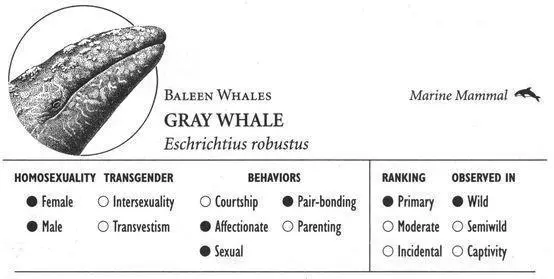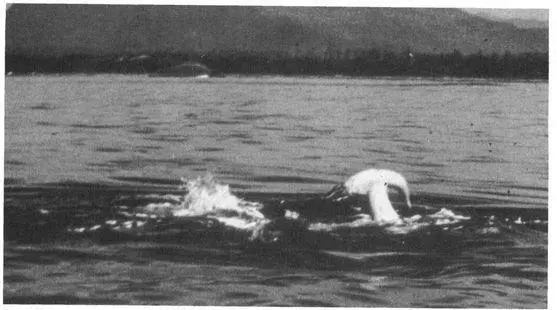Olesiuk, P. F., M. A. Bigg, and G. M. Ellis (1990) “Life History and Population Dynamics of Resident Killer Whales ( Orcinus orca ) in the Coastal Waters of British Columbia and Washington State.” In P. S. Hammond, S. A. Mizroch, and G. P. Donovan, eds., Individual Recognition of Cetaceans: Use of Photo-Identification and Other Techniques to Estimate Population Parameters , pp. 209-43. Report of the International Whaling Commission, Special Issue 12. Cambridge, UK: International Whaling Commission.
*Osborne, R. W. (1986) “A Behavioral Budget of Puget Sound Killer Whales.” In B. C. Kirkevold and J. S. Lockard, eds., Behavioral Biology of Killer Whales , pp. 211-49. New York: Alan R. Liss.
Reeves, R. R., and E. Mitchell (1988) “Distribution and Seasonality of Killer Whales in the Eastern Canadian Arctic.” In J. Sigurjónsson and S. Leatherwood, eds., North Atlantic Killer Whales , pp. 136–60. Rit Fiskideildar (Journal of the Marine Research Institute, Reykjavik) , vol. 11. Reykjavik: Hafrannsók-nastofnunin.
*Rose, N.A. (1992) “The Social Dynamics of Male Killer Whales, Orcinus orca, in Johnstone Strait, British Columbia.” Ph.D. thesis, University of California–Santa Cruz.
*Saulitis, E. L. (1993) “The Behavior and Vocalizations of the ‘AT’ Group of Killer Whales (Orcinus orca) in Prince William Sound, Alaska.” Master’s thesis, University of Alaska.
*Utrecht, W. L. van (1960) “Notat om den hermafroditte spermhval/Note on the ‘Hermaphrodite Sperm Whale.’” Norsk Hvalfangst-Tidende 49:520.

IDENTIFICATION: A baleen whale (fringed plates in the mouth are used to filter food) reaching 38–48 feet in length and 27–37 tons (males are slightly smaller than females); characterized by its grayish color, tufts of bristly hairs on its head, and distinctive white splotches and bumps on skin surface that differ like “fingerprints” for each individual. DISTRIBUTION: West coast of North America from Baja California to Arctic Ocean; from southern Korea and Japan to Sea of Okhotsk. HABITAT: Shallow coastal waters, fjordlike inlets, open oceans. STUDY AREA: Wickaninnish Bay, Vancouver Island, British Columbia, Canada.
Social Organization
For eight months of the year—during the migration and summering periods—Gray Whales generally travel and socialize in sex-segregated groups (sometimes known as PODS), while for the remaining time the two sexes are together. Gray Whales have one of the longest migration routes of any mammal: they spend their summers feeding in northern waters, while in the fall they head south on a four-month journey to the mangrove lagoons off Baja California where they mate and their calves are born, only to return to their northern waters in the early spring. A few populations of Gray Whales are nonmigratory, remaining year-round in northern waters.
Description
Behavioral Expression: Male homosexual interactions among Gray Whales occur frequently in the northern summering waters and during the northward migration. Sexual and affectionate activities occur close to the surface of the water in long sessions lasting anywhere from 30 minutes to more than an hour and a half. Often more than two males are involved, sometimes as many as four or five. The whales begin by rolling around each other and onto their sides, with much splashing of water, flailing of fins and flukes at the surface, and occasional slapping of the surface and blowing; sometimes two males rise out of the water several feet in a throat-to-throat position. The whales rub their bellies together and position themselves so that their genital areas are in contact, and usually one or more has an arching, erect or semi-erect penis (which is a distinctive light pink in color and may be three to five feet in length and a foot in circumference at its base). Often two or more males intertwine their penises above the water surface, or one male may lay his erect penis on another male’s belly or perhaps nudge the other’s penis with his head. Female homosexual interactions may also occur.
Penis intertwining between two male Gray Whales off the coast of Vancouver Island (the erect organs of the two males are visible above the surface of the water)

Gray Whales also frequently form same-sex companionships (pairs and trios) that travel and feed together throughout the summer (without necessarily engaging in sexual activity with one another). They swim in an intimate side-by-side position, often with their side fins touching, and travel back and forth along the length of coastal inlets for hours at a time, apparently with no particular purpose other than to be together. Such companions also perform synchronized blowing and diving maneuvers, including feeding and BREACHING (an acrobatic leap two-thirds out of the water, landing with a dramatic splash on their sides or backs). Two whales also often roll over and under each other, rubbing bellies. Both short-term and long-term (recurring) pair- and trio-bonds occur: some last only for a few hours or days, with the whales changing partners several times over the summer; other companionships endure from year to year.
Frequency: Homosexual activity is fairly common in Gray Whales outside the breeding season, and can be seen perhaps as often as five or six times a month in the early spring in some populations. Actual frequencies may be higher, since much sexual activity probably occurs underwater or in locations that are otherwise difficult to observe. At least a quarter of all companion pairs and trios are same-sex.
Orientation: The majority of male Gray Whales are probably bisexual, interacting primarily with each other on the migrations and during the summer in the north, and interacting heterosexually in the calving waters in the south.
Nonreproductive and Alternative Heterosexualities
Migration in Gray Whales involves a lot more than travel: feeding, nursing, and sexual activity all take place during the journey. Migrating pods are separated according to the sex, age, and reproductive status of the whales: on the northward migration, for example, newly pregnant females usually leave first, then adult males, followed by nonovulating and immature females, immature males, and lastly females with new calves. Male Gray Whales also have a distinct seasonal sexual cycle related to sperm production: during the northward migration and the summer months, their testes are essentially inactive, producing little or no sperm; on the southward migration sperm production resumes and peaks in late fall and early winter in preparation for heterosexual breeding. Consequently, for two-thirds of the year, male Gray Whales are nonfertile, even though they sometimes engage in heterosexual copulation during these times. Combined with the female sexual cycle (with its infertile period in the spring and summer) and the fact that sexual interactions outside the mating season may involve groups of whales (not all of whom copulate), this means that a significant portion of heterosexual activity is nonreproductive. Furthermore, heterosexual courtship and copulation during the mating season also sometimes involves groups of up to 18 whales interacting at the same time, and both males and females mate with multiple partners. During the actual mating act, trios consisting of two males and one female are sometimes involved: one male is a “helper” who does not interact sexually with the female, but seems instead to assist the other two to align their bodies and maintain their position during copulation. Females usually breed only every other year, and some wait two years between calves.
Читать дальше














